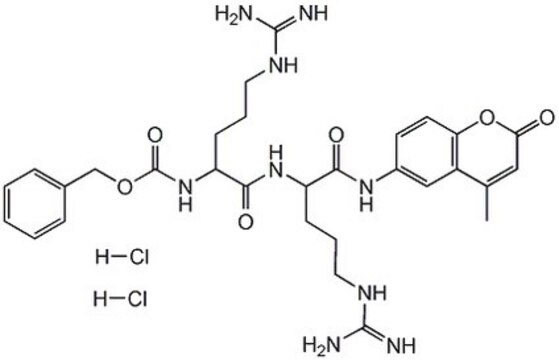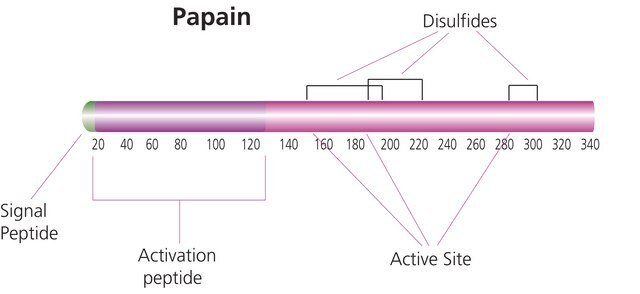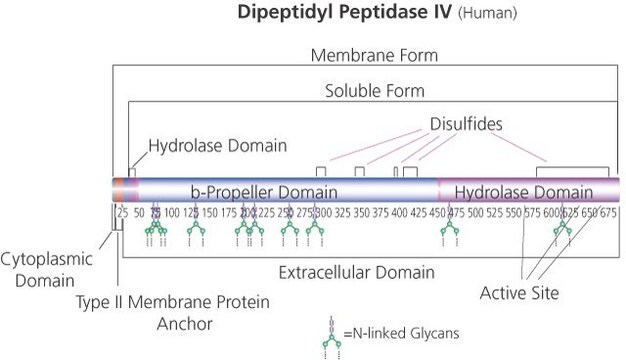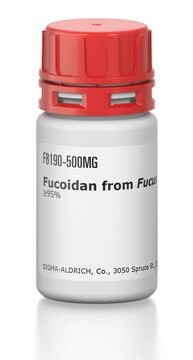C8511
Cathepsin C from bovine spleen
Type X, lyophilized powder, ≥5 units/mg protein
Sinónimos:
Dipeptidyl aminopeptidase, Dipeptidyl peptidase I
Iniciar sesiónpara Ver la Fijación de precios por contrato y de la organización
About This Item
Productos recomendados
Application
Cathepsin C has been used in a study that demonstrated the potential of a proteomics approach to identify novel proteins expressed by extravillous trophoblast and to uncover the mechanisms leading to disease states in pregnancy. Cathepsin C has also been used in a study to evaluate biodegradable thermogels.
The enzyme from Sigma has been used in the activation of granzyme k (Gzmk) precursor from E. coli. Granzymes are granule-stored lymphocyte serine proteases that are implicated in T- and natural killer cell-mediated cytotoxic defense reactions.
Biochem/physiol Actions
Cathespin C is a dipeptidyl aminopeptidase that can sequentially remove dipeptides from a peptide chain with an unsubstituted N-terminus. The enzyme exhibits a preference for glycine and proline as N-terminal aminoacids. Substrates that have an N-terminal lysyl or arginyl residue, or a penultimate proryl residue are not targeted by this enzyme. The endopeptidase activity requires the presence of halide ions and sulfydryl activators.
Caution
Unstable. Keep frozen.
Unit Definition
One unit will produce 1 μmole of Gly-Phe-NHOH from Gly-Phe-NH2 and hydroxylamine per min at pH 6.8 at 37 °C using DL-phenylalanine hydroxamic acid as the standard. In addition to its hydrolytic properties, cathepsin C catalyzes the polymerization of dipeptide amides.
Physical form
Lyophilized from a 1 M sodium chloride solution.
substrate
Referencia del producto
Descripción
Precios
Storage Class
11 - Combustible Solids
wgk_germany
WGK 3
flash_point_f
Not applicable
flash_point_c
Not applicable
ppe
Eyeshields, Gloves, type N95 (US)
Elija entre una de las versiones más recientes:
¿Ya tiene este producto?
Encuentre la documentación para los productos que ha comprado recientemente en la Biblioteca de documentos.
Los clientes también vieron
The specificity of dipeptidyl transferase.
I M Voynick et al.
Biochemistry, 7(1), 40-44 (1968-01-01)
H Lindley
The Biochemical journal, 126(3), 683-685 (1972-02-01)
1. The characterization of cathepsin C as an aminodipeptidase has been confirmed. 2. An extra limitation on its specificity, namely that peptides involving proline as the third residue are immune to the enzyme, has been found. 3. A novel technique
High immunoglobulin E in a Chinese Papillon-Lefèvre syndrome patient with novel compound mutations of cathepsin C.
Xuan Wen et al.
The Journal of dermatology, 39(7), 664-665 (2012-01-10)
Case of rippled-pattern sebaceoma with clinically yellowish surface and histopathological paucity of lipid-containing neoplastic cells.
Yoshio Kawakami et al.
The Journal of dermatology, 39(7), 644-646 (2011-11-15)
Mayumi Ueta et al.
Japanese journal of ophthalmology, 55(4), 405-410 (2011-05-28)
We previously reported that human conjunctival epithelial cells expressed functioning interleukin-4 receptor α (IL-4Rα). In this study, we investigated whether human corneal epithelial cells also express functioning IL-4Rα. The presence of IL-4Rα mRNA and protein in human corneal epithelium was
Nuestro equipo de científicos tiene experiencia en todas las áreas de investigación: Ciencias de la vida, Ciencia de los materiales, Síntesis química, Cromatografía, Analítica y muchas otras.
Póngase en contacto con el Servicio técnico





